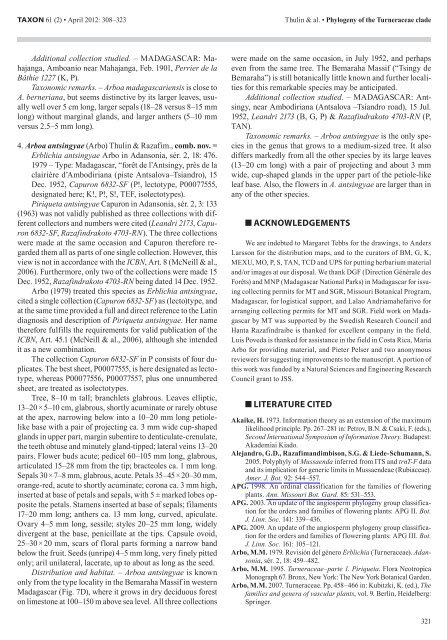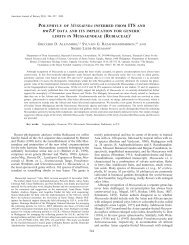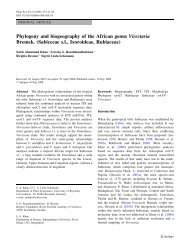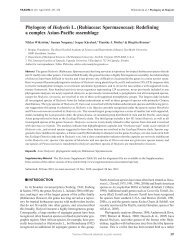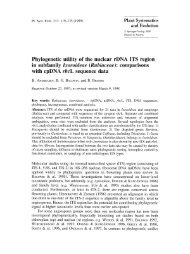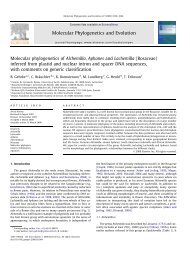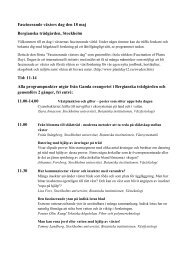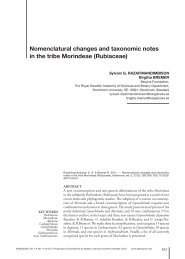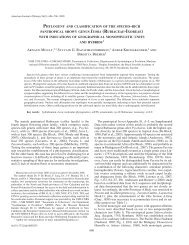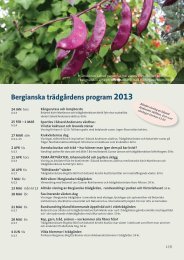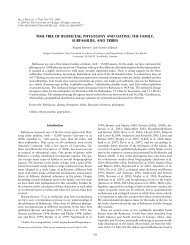Thulin et al. 2012
Thulin et al. 2012
Thulin et al. 2012
Create successful ePaper yourself
Turn your PDF publications into a flip-book with our unique Google optimized e-Paper software.
TAXON 61 (2) • April <strong>2012</strong>: 308–323<br />
Addition<strong>al</strong> collection studied. – MADAGASCAR: Mahajanga,<br />
Amboanio near Mahajanga, Feb. 1901, Perrier de la<br />
Bâthie 1227 (K, P).<br />
Taxonomic remarks. – Arboa madagascariensis is close to<br />
A. berneriana, but seems distinctive by its larger leaves, usu<strong>al</strong>ly<br />
well over 5 cm long, larger sep<strong>al</strong>s (18–28 versus 8–15 mm<br />
long) without margin<strong>al</strong> glands, and larger anthers (5–10 mm<br />
versus 2.5–5 mm long).<br />
4. Arboa antsingyae (Arbo) <strong>Thulin</strong> & Razafim., comb. nov. ≡<br />
Erblichia antsingyae Arbo in Adansonia, sér. 2, 18: 476.<br />
1979 – Type: Madagascar, “forêt de l’Antsingy, près de la<br />
clairière d’Ambodiriana (piste Ants<strong>al</strong>ova–Tsiandro), 15<br />
Dec. 1952, Capuron 6832-SF (P!, lectotype, P00077555,<br />
designated here; K!, P!, S!, TEF, isolectotypes).<br />
Piriqu<strong>et</strong>a antsingyae Capuron in Adansonia, sér. 2, 3: 133<br />
(1963) was not v<strong>al</strong>idly published as three collections with different<br />
collectors and numbers were cited (Leandri 2173, Capuron<br />
6832-SF, Razafindrakoto 4703-RN). The three collections<br />
were made at the same occasion and Capuron therefore regarded<br />
them <strong>al</strong>l as parts of one single collection. However, this<br />
view is not in accordance with the ICBN, Art. 8 (McNeill & <strong>al</strong>.,<br />
2006). Furthermore, only two of the collections were made 15<br />
Dec. 1952, Razafindrakoto 4703-RN being dated 14 Dec. 1952.<br />
Arbo (1979) treated this species as Erblichia antsingyae,<br />
cited a single collection (Capuron 6832-SF) as (lecto)type, and<br />
at the same time provided a full and direct reference to the Latin<br />
diagnosis and description of Piriqu<strong>et</strong>a antsingyae. Her name<br />
therefore fulfills the requirements for v<strong>al</strong>id publication of the<br />
ICBN, Art. 45.1 (McNeill & <strong>al</strong>., 2006), <strong>al</strong>though she intended<br />
it as a new combination.<br />
The collection Capuron 6832-SF in P consists of four duplicates.<br />
The best she<strong>et</strong>, P00077555, is here designated as lectotype,<br />
whereas P00077556, P00077557, plus one unnumbered<br />
she<strong>et</strong>, are treated as isolectotypes.<br />
Tree, 8–10 m t<strong>al</strong>l; branchl<strong>et</strong>s glabrous. Leaves elliptic,<br />
13–20 × 5–10 cm, glabrous, shortly acuminate or rarely obtuse<br />
at the apex, narrowing below into a 10–20 mm long p<strong>et</strong>iolelike<br />
base with a pair of projecting ca. 3 mm wide cup-shaped<br />
glands in upper part, margin subentire to denticulate-crenulate,<br />
the te<strong>et</strong>h obtuse and minutely gland-tipped; later<strong>al</strong> veins 13–20<br />
pairs. Flower buds acute; pedicel 60–105 mm long, glabrous,<br />
articulated 15–28 mm from the tip; bracteoles ca. 1 mm long.<br />
Sep<strong>al</strong>s 30 × 7–8 mm, glabrous, acute. P<strong>et</strong><strong>al</strong>s 35–45 × 20–30 mm,<br />
orange-red, acute to shortly acuminate; corona ca. 3 mm high,<br />
inserted at base of p<strong>et</strong><strong>al</strong>s and sep<strong>al</strong>s, with 5 ± marked lobes opposite<br />
the p<strong>et</strong><strong>al</strong>s. Stamens inserted at base of sep<strong>al</strong>s; filaments<br />
17–20 mm long; anthers ca. 13 mm long, curved, apiculate.<br />
Ovary 4–5 mm long, sessile; styles 20–25 mm long, widely<br />
divergent at the base, penicillate at the tips. Capsule ovoid,<br />
25–30 × 20 mm, scars of flor<strong>al</strong> parts forming a narrow band<br />
below the fruit. Seeds (unripe) 4–5 mm long, very finely pitted<br />
only; aril unilater<strong>al</strong>, lacerate, up to about as long as the seed.<br />
Distribution and habitat. – Arboa antsingyae is known<br />
only from the type loc<strong>al</strong>ity in the Bemaraha Massif in western<br />
Madagascar (Fig. 7D), where it grows in dry deciduous forest<br />
on limestone at 100–150 m above sea level. All three collections<br />
<strong>Thulin</strong> & <strong>al</strong>. • Phylogeny of the Turneraceae clade<br />
were made on the same occasion, in July 1952, and perhaps<br />
even from the same tree. The Bemaraha Massif (“Tsingy de<br />
Bemaraha”) is still botanic<strong>al</strong>ly little known and further loc<strong>al</strong>ities<br />
for this remarkable species may be anticipated.<br />
Addition<strong>al</strong> collection studied. – MADAGASCAR: Antsingy,<br />
near Ambodiriana (Ants<strong>al</strong>ova –Tsiandro road), 15 Jul.<br />
1952, Leandri 2173 (B, G, P) & Razafindrakoto 4703-RN (P,<br />
TAN).<br />
Taxonomic remarks. – Arboa antsingyae is the only species<br />
in the genus that grows to a medium-sized tree. It <strong>al</strong>so<br />
differs markedly from <strong>al</strong>l the other species by its large leaves<br />
(13–20 cm long) with a pair of projecting and about 3 mm<br />
wide, cup-shaped glands in the upper part of the p<strong>et</strong>iole-like<br />
leaf base. Also, the flowers in A. antsingyae are larger than in<br />
any of the other species.<br />
ACKNOWLEDGEMENTs<br />
We are indebted to Margar<strong>et</strong> Tebbs for the drawings, to Anders<br />
Larsson for the distribution maps, and to the curators of BM, G, K,<br />
MEXU, MO, P, S, TAN, TCD and UPS for putting herbarium materi<strong>al</strong><br />
and/or images at our dispos<strong>al</strong>. We thank DGF (Direction Génér<strong>al</strong>e des<br />
Forêts) and MNP (Madagascar Nation<strong>al</strong> Parks) in Madagascar for issuing<br />
collecting permits for MT and SGR, Missouri Botanic<strong>al</strong> Program,<br />
Madagascar, for logistic<strong>al</strong> support, and L<strong>al</strong>ao Andriamahefarivo for<br />
arranging collecting permits for MT and SGR. Field work on Madagascar<br />
by MT was supported by the Swedish Research Council and<br />
Hanta Razafindraibe is thanked for excellent company in the field.<br />
Luis Poveda is thanked for assistance in the field in Costa Rica, Maria<br />
Arbo for providing materi<strong>al</strong>, and Pi<strong>et</strong>er Pelser and two anonymous<br />
reviewers for suggesting improvements to the manuscript. A portion of<br />
this work was funded by a Natur<strong>al</strong> Sciences and Engineering Research<br />
Council grant to JSS.<br />
LITERATURE CITED<br />
Akaike, H. 1973. Information theory as an extension of the maximum<br />
likelihood principle. Pp. 267–281 in: P<strong>et</strong>rov, B.N. & Csaki, F. (eds.),<br />
Second Internation<strong>al</strong> Symposium of Information Theory. Budapest:<br />
Akademiai Kiado.<br />
Alejandro, G.D., Razafimandimbison, S.G. & Liede-Schumann, S.<br />
2005. Polyphyly of Mussaenda inferred from ITS and trnT-F data<br />
and its implication for generic limits in Mussaendeae (Rubiaceae).<br />
Amer. J. Bot. 92: 544–557.<br />
APG. 1998. An ordin<strong>al</strong> classification for the families of flowering<br />
plants. Ann. Missouri Bot. Gard. 85: 531–553.<br />
APG. 2003. An update of the angiosperm phylogeny group classification<br />
for the orders and families of flowering plants: APG II. Bot.<br />
J. Linn. Soc. 141: 339–436.<br />
APG. 2009. An update of the angiosperm phylogeny group classification<br />
for the orders and families of flowering plants: APG III. Bot.<br />
J. Linn. Soc. 161: 105–121.<br />
Arbo, M.M. 1979. Revisión del género Erblichia (Turneraceae). Adansonia,<br />
sér. 2, 18: 459–482.<br />
Arbo, M.M. 1995. Turneraceae–parte 1. Piriqu<strong>et</strong>a. Flora Neotropica<br />
Monograph 67. Bronx, New York: The New York Botanic<strong>al</strong> Garden.<br />
Arbo, M.M. 2007. Turneraceae. Pp. 458–466 in: Kubitzki, K. (ed.), The<br />
families and genera of vascular plants, vol. 9. Berlin, Heidelberg:<br />
Springer.<br />
321


